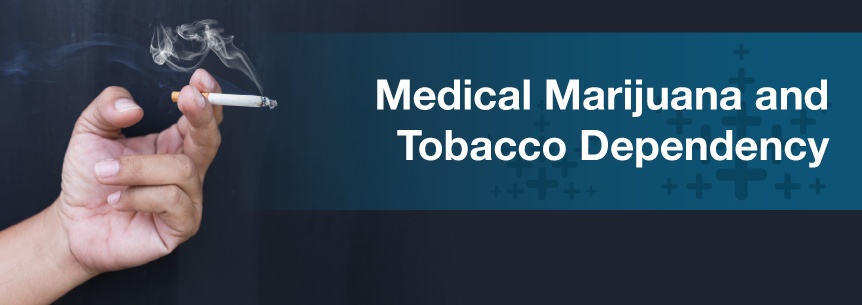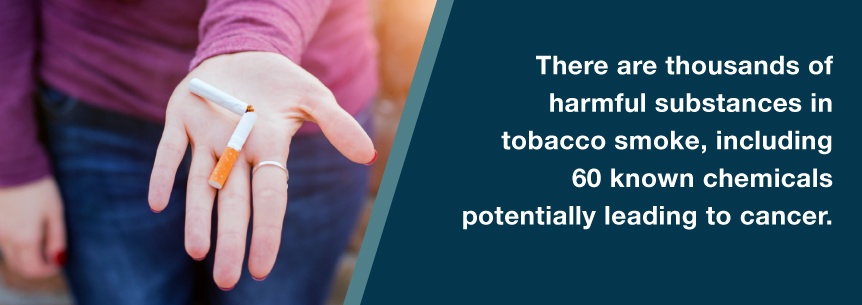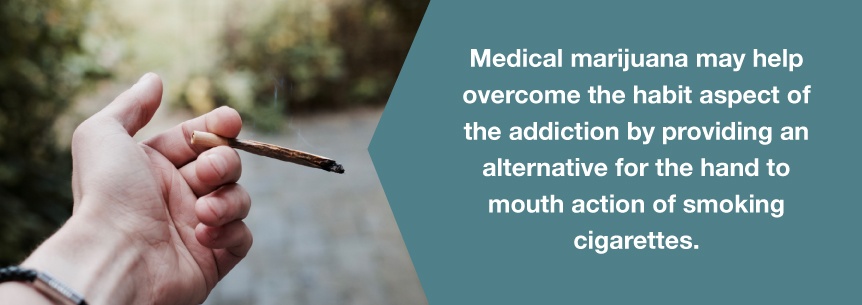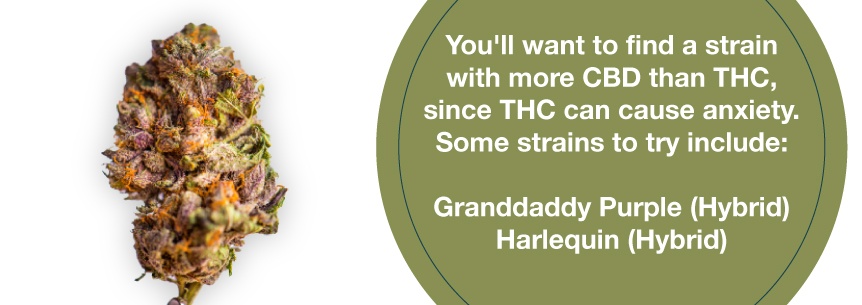
While marijuana was at one time thought of as a “drug of abuse,” recently numerous studies are showing the plant and several of its compounds are useful in treating addiction. Researchers are now studying medical marijuana and tobacco dependence.
Tobacco is a very addictive substance that is widely abused worldwide. It also kills up to six million people each year, according to the Centers for Disease Control and Prevention (CDC), making it the top cause of preventable death.
Tobacco dependence, also referred to as nicotine dependence, occurs when a person has an addiction to tobacco products due to the nicotine drug in them. Tobacco dependence means you’re not able to stop using the tobacco, despite its adverse effect on your health.
Nicotine produces a temporarily pleasing effect. Because it makes you feel good, you crave it, which leads to dependence on the tobacco that contains it. Stopping tobacco use when addicted also causes withdrawal symptoms, including anxiety and irritability.
Tobacco dependence may affect anybody who smokes. Many individuals who smoke regularly started when they were teens or younger. The younger you are when you begin to smoke, the higher the chance you’ll experience dependence. The New England Journal of Medicine conducted a study showing around 80 percent of individuals with tobacco dependence began smoking before they were 18 years old.
Although tobacco’s nicotine content is what causes tobacco dependence, tobacco also has toxic effects deriving from its other substances. Smokers also have a higher rate of stroke, heart disease, and cancer than people who don’t smoke.
No matter how long you’ve been smoking, quitting now can improve your health. And, there are some effective treatments to help you stop smoking, manage your withdrawal symptoms and eliminate your tobacco dependence.
Anybody who smokes cigarettes or uses other types of tobacco products is at risk of tobacco dependence. Factors influencing what individuals will begin using tobacco include:

For some individuals, it doesn’t matter how much tobacco they use. They can quickly become dependent on nicotine. Signs and symptoms of tobacco dependence include:
The symptoms each person experiences will be different, and some will become dependent on nicotine rather quickly.
The nicotine in tobacco is a chemical spurring you to keep smoking. It’s extremely addictive when you receive it through inhalation, and smoke flows into your lungs. This is because the nicotine is quickly released into your blood and takes only seconds after you take a puff for it to reach your brain. The nicotine increases the release of neurotransmitters (brain chemicals) in your brain to help regulate behavior and mood.
Among these neurotransmitters is dopamine. When this chemical reaches your brain’s “reward center,” it causes feelings of pleasure and improves your mood. It’s the experience of these effects nicotine causes that makes tobacco addictive.
Tobacco dependence involves physical factors as well as behavioral factors like habits, routines, and feelings. These behavioral factors linked to smoking could act as a trigger — feelings or situations activating your tobacco craving.
Some behavioral factors and triggers you might link with smoking are:
To overcome your tobacco dependence, you’ll need to learn your triggers and come up with a plan to deal with the routines and behaviors you link with smoking.
Some experts separate different dependencies such as:
With smoking, a physical dependence would occur because of nicotine’s impact on the brain. The behavioral and psychological dependence is related to other factors, like smoking in a particular situation or state of mind. For some individuals, their craving to smoke comes when they drink coffee, drive or read a book. For others, it’s when they’re in the presence of other people who smoke.
There are thousands of harmful substances in tobacco smoke, including 60 known chemicals potentially leading to cancer. Even herbal or “all natural” cigarettes have harmful chemicals in them.

Smoking damages not just your lungs, but just about every organ in your body. It also impairs your immune system. Around 50 percent of regular smokers will end up dying from a disease that tobacco causes.
Some of the negative health effects tobacco causes are:
Almost nine out of 10 cases of lung cancer develop from smoking. Smoking also causes other lung diseases like chronic bronchitis and emphysema. It can make asthma worse as well.
Smoking also causes cancers of the:
It’s also related to cancers of the:
Overall, 30 percent of all cancer-related deaths are from smoking.
Insulin resistance builds up from smoking, which could set the stage for developing type 2 diabetes. Smoking can expedite the progress of complications like eye problems and kidney disease in people with diabetes as well.
When you smoke, it increases your risk of dying from cardiovascular and heart disease, including stroke and heart attack. Your risk of heart disease increases even if you smoke only one to four cigarettes a day.
If you have cardiovascular or heart diseases like heart failure, your condition becomes worse from smoking. Fortunately, you can reduce your heart attack risk by 50 percent in your first year you stop smoking.
Smoking increases a man’s risk of impotence and a woman’s risk of infertility.
Smoking increases your risk of severe eye problems like cataracts and macular degeneration-related eyesight loss.
Smoking increases your risk of gingivitis, or gum inflammation, and periodontitis, a severe gum infection that could destroy your teeth’s support system.
When a mom-to-be smokes when she’s pregnant, she’s at a higher risk of:
Tobacco smoke’s chemicals may change your skin structure, causing wrinkles and premature aging. It also yellows your fingers, teeth and fingernails.
Those who smoke have a higher risk of respiratory infections like a cold, flu or bronchitis.
When you smoke, it deadens your smell and taste senses, making food less appetizing.
You put your family members at risk of heart disease and lung cancer by smoking in front of them. Smoking around your kids will put them at risk of worsening asthma, SIDS, colds and ear infections.
According to a study, individuals with tobacco dependence had higher rates of anxiety disorders and major depression. The level of severity of tobacco dependence determines how strong these associations are.
Another study showed at baseline, general anxiety, depression and agoraphobia symptoms were more severe in tobacco-dependent smokers than they were in former smokers, never-smokers and non-dependent smokers.
Tobacco dependency figures according to the National Institutes of Health (NIH) include:
Tobacco originated in America in temperate climates. The native populations smoked and chewed the leaves while spreading the plant across America. Tobacco had reached the other side of the continent and islands close by before Columbus’s San Salvador landing in 1492. Tobacco leaves became a form of barter. As Portuguese, Spanish and English sailors began introducing tobacco use at ports in the 1500s, tobacco use began spreading.
The physical dependence part of nicotine addiction can be challenging to deal with. Individuals need to work hard at changing routines and behaviors. Numerous treatment options for tobacco dependence are available, including medications, support groups, and nicotine replacement therapy:
Your doctor can prescribe you a medication to help you to quit smoking. These medications work by lessening your cravings. Some nicotine replacement therapy options are gums, patches, nasal sprays, lozenges or inhalers. They provide you with nicotine, but you don’t get the other chemicals like you would with tobacco. They help you beat your addiction gradually and methodically.
Side effects of smoking cessation drugs include:
Antidepressants are another option to quit smoking that doesn’t contain nicotine. They work by increasing your dopamine production, thus improving your mood. Side effects of antidepressants include:
Whether you choose a virtual support group or an in-person one, they can help you work through your tobacco dependence by teaching you coping skills. They also provide you with a way of meeting other people who are going through the same challenges of addiction.
Innovative neuroimaging technologies have helped researchers and doctors identify brain changes linked with smoking and tobacco dependence. Using MRI scans, researchers can visualize the brains of smokers as they respond to cues associated with cigarettes triggering cravings and relapse. Their research could be a biomarker for monitoring treatment progress and relapse risk. It can also point to brain regions involved in nicotine addiction development.
There is insufficient research in the area of medical marijuana and tobacco dependence. In fact, there is very little research in the area of medical marijuana and addiction to anything. Nonetheless, there is anecdotal evidence to suggest individuals with tobacco dependence are successfully treating their condition with medical marijuana. Doctors are prescribing medical marijuana for this condition in areas where medical marijuana is legal for addiction treatment.
While clinical and pre-clinical trials treatment of dependence with medical marijuana is in its infancy, there is enough to suggest there needs to be more research. The number of people who have attempted to quit using traditional methods and have failed along with the health problems associated with smoking shows there need to be more treatments.
Therefore, further research is not only indicated by the results of current research, but it is also worthwhile to search for new treatments for tobacco dependence as the current treatments do not help enough sufferers.
Both subjective experience and observation show tobacco dependence is similar in severity to that of highly addictive substances like heroin and cocaine. It turns out medical marijuana can treat even these notoriously addictive substances. Zheng-Xiong Xi of the National Institute on Drug Abuse headed up a study using a synthetic cannabidiol known as JWH133 on cocaine-addicted mice. Researchers gave the mice access to intravenous cocaine. When the mice received JWH133, they used the cocaine 50 to 60 percent less than they had before being given medical marijuana.
Observations also showed the animals did not appear to get high off the drug or experience negative side effects. For tobacco dependency, this could be a boon. Individuals with tobacco dependency often smoke cigarettes throughout the day. Psychoactive marijuana is not typically a viable option for the average smoker because they often do not want to be “stoned” all day. Treatments that decrease addiction without impairing cognitive function are preferable to many.
Addiction research shows habits can be just as much as a draw to a substance as addiction. Cigarette smokers appear to be the most vulnerable as they often smoke in certain places, at certain times and on a daily basis.
Common places and times triggering cravings are cars, after meals, upon waking and when bored. Medical marijuana may help overcome the habit aspect of the addiction by providing an alternative for the hand to mouth action of smoking cigarettes. It can also replace the feel of smoking that smokers often enjoy.

As research progresses, scientists can discover precisely which active components in medical marijuana are useful for the treatment of tobacco dependence. This will give patients more options suiting their needs, such as discreet ingestion methods or non-psychoactive treatment.
Current patients receiving medical marijuana treatment for tobacco dependence should talk to their doctors about their options and their individual needs. No addiction treatment can work if it is inconvenient for the patient. This is especially so for tobacco dependence because it does not carry the stigma of other addictive substances. Avoiding treatment will never result in jail time.
In a study, researchers found CBD helps reduce addiction to cigarette smoking. The study’s participants lowered their cigarette use by 40 percent with the use of a CBD inhaler.
Other studies suggest manipulating the endocannabinoid system (ECS) through the SR-141716A (rimonabant) CB1 receptor antagonist could be a new therapy to treat addiction.
Cannabis works well at easing many withdrawal symptoms of quitting smoking. For instance, cannabis for tobacco dependence can help relieve:
Some good marijuana and tobacco dependence strains you may want to try are as follows:
Certain cannabis strains work well for treating headaches — some better than others. Some good strains to try to relieve your withdrawal-related headaches are:
You’ll want to find a strain with more CBD than THC, since THC can cause anxiety. Some strains to try include:

The strains below can boost your mood and provide you with a more positive outlook:
Some strains that may work well for insomnia include:
Common ways of receiving your medical cannabis for tobacco dependence are smoking it, consuming it orally, using a suppository or sticking it under your tongue. You may also apply it directly to your skin through the use of cannabis-infused ointments and oils.
Some of your options include:
Keep in mind, smoking marijuana can lead to the same adverse respiratory effects that smoking tobacco causes, so it may not be the best method of ingesting cannabis compared to other methods, like marijuana edibles.
If you’ve decided you’d like to try marijuana for tobacco dependence, use our abundance of resources and information on this medicinal herb at MarijuanaDoctors.com. While perusing the site, you’ll find a comprehensive list of dispensaries and qualified cannabis doctors to help you start your treatment of cannabis for tobacco dependence. Book your appointment today with one of our doctors.
Find A Doctor Find A Dispensary


Please allow us to access your location to find local dispensaries.
VIEW ALL DISPENSARIES ➔